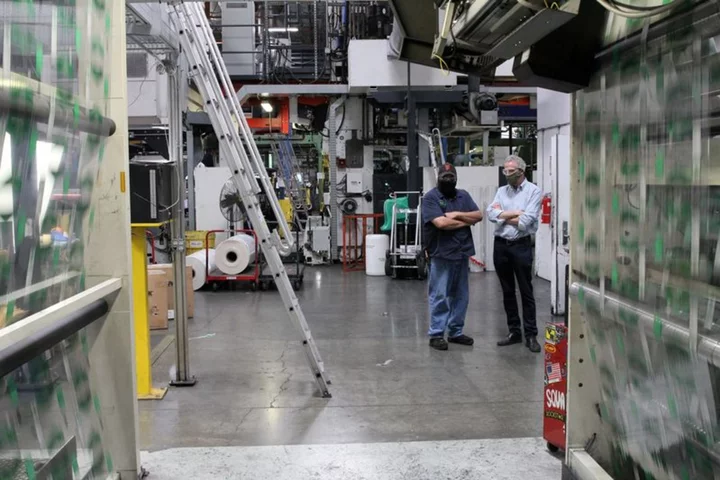By Timothy Aeppel
When storms hammered California's farms last winter, Kevin Kelly knew his small factory outside San Francisco would soon see demand wilt for the plastic bags it churns out for pre-cut salads and other produce.
In the past, he would have swiftly chopped 10% of the workers that run his bag-making machines, or about 15 people.
But after struggling to fill jobs during the boom triggered by the COVID-19 pandemic, he didn't this time. "I knew it would be hard to find people when business came back, let alone train them," said Kelly, the CEO of Emerald Packaging. So he held on to his employees and found ways to curb their hours, including cutting overtime.
Employers across the U.S. are making a similar calculation. Faced with the tightest job market in decades, many have become less trigger-happy with layoffs, even in the face of a cooling economy. Indeed, a monthly report from outplacement firm Challenger, Gray & Christmas on Thursday showed that announced layoffs hit their lowest level in nearly a year last month as companies were "weary of letting go of needed workers."
It's unclear whether this strategy - dubbed labor hoarding by economists - would endure if the economy slipped into a deep recession, as some have predicted it would after the Federal Reserve embarked last year on an aggressive campaign to raise interest rates to curb high inflation.
But, so far, the economy has continued to grow, albeit more slowly, and the job market has powered onward. Ahead of the Labor Department's release on Friday of the monthly employment report for July, the U.S. jobless rate stood at 3.6% in June - up only slightly from more than a half-century low of 3.4% earlier in the year.
'HOLD ONTO YOUR LABOR FORCE'
At least one major company has adopted a formal strategy of hoarding workers.
Speaking to investors last December, Alan H. Shaw, the CEO of Norfolk Southern, said part of a larger strategy aimed at making the railroad company more competitive with trucking would be to avoid the cycle in which workers are furloughed during downturns and then rehired when the economy improves. Shaw said difficulties bringing back workers hurt the Atlanta-based firm's ability to serve customers during the pandemic boom.
The strategy is being put to the test now, as rail volumes have fallen back to earth after that boom ended. "But we're continuing to hire," Shaw told Reuters this week, "because we have confidence in the U.S. economy and the U.S. consumer."
While many companies aren't hiring at the heated pace they were a year ago, they're also not yet rushing to thin the ranks.
U.S. job openings fell to the lowest level in more than two years in June, according to the monthly Job Openings and Labor Turnover Survey, or JOLTS report, released by the Labor Department this week, but they remained at levels consistent with a tight labor market. Layoffs and involuntary separations hit a six-month low.
"There's a lot of hoarding going on - and still lots of hiring in industries that are experiencing strong demand," said Dana Peterson, the chief economist at the Conference Board in New York.
The group's latest survey of CEO confidence, done in conjunction with the Business Council and released on Thursday, found that while business leaders continue to prepare for a downturn, the fight for workers remains fierce. Forty percent of the CEOs said they plan to increase hiring in the next 12 months, while another 40% intend to maintain the size of their workforces.
The survey showed most CEOs expect the next downturn to be short and shallow. "If that's the case," said Peterson, "it makes sense to hold onto your labor force."
LAYOFF REGRETS
Arnold Kamler, the CEO of Kent International, learned that the hard way. Demand for the bicycles that the company imports and manufactures at a small factory in South Carolina was insatiable during the pandemic. But as lockdowns eased, bike sales evaporated, and inventories piled up in the company's warehouses and even in corners of its factory.
He laid off 60% of the workers at the company's South Carolina plant at the end of last year, but now regrets it.
"I thought that when we went to rehire in March, we would have no problem ramping up," he said. But only about a third of the workers returned and the company is now scrambling to find and train new employees. The factory currently has 85 workers, but Kamler would like 110.
Julia Pollak, chief economist at ZipRecruiter in Los Angeles, said employers tell her they are retaining workers they wouldn't normally keep because of concerns they will have problems ramping up. But she sees a limit to this. "I don't think it's the case that many businesses are holding onto workers who are idle," she said.
Thomas Simons, senior U.S. economist at Jefferies, has argued for months that at some stage the need for businesses to recapture margin will outweigh the argument for retaining under-used staff as a hedge against the difficulty of later rehiring. But that "view is becomingly increasingly difficult to defend," he said last week after data showed weekly new claims for unemployment benefits hit their lowest level since February. Data released on Thursday showed weekly jobless claims rose slightly in the latest week.
Meanwhile, at Emerald Packaging, business has recovered from the slowdown caused by the winter storms.
"We're actually making more money now than when demand was skyrocketing," Kelly said, because surging prices for raw materials such as plastic resins cut into profits during the boom.
And for now, the company is continuing to hire. "We're still 15 to 18 (people) short," he said.
(Reporting by Timothy Aeppel; Editing by Dan Burns and Paul Simao)

